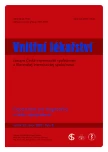Encapsulating peritoneal sclerosis
Authors:
L. Fantová 1,3; R. Šafářová 1,2; S. Vaňková 1,2
Authors‘ workplace:
Dialyzační středisko EuroCare, Praha 4, vedoucí prim. MUDr. Světlana Vaňková
1; 3. lékařská fakulta UK, Praha
2; Nefrologická ambulance Centromed a. s., Praha, ředitelka MUDr. Milana Dokulilová
3
Published in:
Vnitř Lék 2007; 53(2): 164-168
Category:
Review
Overview
Encapsulating peritoneal sclerosis (EPS) is a rare complication of perioneal dialysis characterized by an extensive peritoneal fibrosis and bowel obstruction. The opinion on etiopathogenesis is not unified. An important factor seems to be carrying out peritoneal dialysis itself and exposition of peritoneum to nonphysiological influences (the incidence increases with the length of treatment by peritoneal dialysis). There is also a certain individual perceptivity of patient which is apparently caused by different immunological response. The result of EPS are serious anatomical and functional changes of peritoneum which lead not only to the loss of transport function of peritoneum but also to bowel malfunction and serious malnutrition. Imaging methods (ultrasound, computer tomography) are very important in the diagnostics of EPS, confirmation of diagnosis is histological. No laboratory markers which would mark the development of EPS exist so far. The ways of treatment are diverse, various surgical operations (liberation of bowel loops, resection of peritoneum) are carried out, there is an effort to influence immunological process. The drug of choice remain corticosteroids, Tamoxifen is promising. However, EPS mortality is still very high, between 56-93 %. The illness often progresses even after peritoneal dialysis is finished. The paper summerizes the existing knowledge about EPS, its diagnosis ant therapy.
Key words:
peritoneal dialysis - peritoneal sclerosis - peritoneal solution - peritonitis - bowel obstruction - immunosupression
Sources
1. Cancarini GC, Sandrini M, Vizzardi V et al. Clinical aspects of peritoneal sclerosis. J Nephrol 2001; 14(Suppl. 4): 39-47.
2. Rigby RJ, Hawley CM. Sclerosing peritonitis: the experience in Australia. Nephrol Dial Transplant 1998; 13: 154-159.
3. Garosi G. Different aspects of peritoneal sclerosis. Contrib Nephrol 2003; 140: 18-29.
4. Nakayama M, Maruyama Y, Nemata M. Encapsulating peritoneal sclerosis is a separate entity: con. Perit Dial Int 2005; 25: 107-109.
5. Di Paolo N, Sacchi G, Lorenzoni P et al. Ossification of the peritoneal membrane. Perit Dial Int 2004; 24: 471-477.
6. Kawaguchi Y, Kawanishi H, Mujais S et al. Encapsulating peritoneal sclerosis: Definition, etiology, diagnosis and treatment. Perit Dial Int 2000; 20: 43-55.
7. Klimopoulos S, Katsoulis IE, Margellos V et al. Sclerosing encapsulating peritonitis secondary to CAPD: the effect of fibrotic debridement on further dialysis. J R Coll Surg Edinb 2002; 47: 485-490.
8. Martins LS, Rodrigues AS, Cabrita AN et al. Sclerosing encapsulating peritonitis: a case successfully treated with immunosuppression. Perit Dial Int 1999; 19: 478-481.
9. Junar BJ, McMillan MA Immunosuppression in scleroing peritonitis. Adv Perit Dial 1993; 9: 187-189.
10. Afthentopoulos IE, Passadakis P, Oreopoulos DG et al. Sclerosing peritonitis in continuous ambulatory peritoneal dialysis patiens: one center’s experience and review of the literature. Adv Ren Replace Ther 1998; 5: 353.
11. Fagugli RM, Selvi A, Quintaliani G et al. Immunosuppressive treatment for sclerosing peritonitis. Nephrol Dial Transplant 1999; 14: 1343-1345.
12. Rajani R, Smyth J, Hoffman CG et al. Differential effect of sirolimus vs prednisolone in the treatment of sclerosing encapsulating peritonitis. Nephrol Dial Transplant 2002; 17: 2278-2280.
13. Mori Y, Matsuo S, Sutoh H et al. A case of a dialysis patient with sclerosing peritonitis successfully treated with corticosteroid therapy alone. Am J Kidney Dis 1997; 30: 275-278.
14. Allaria PM, Giangrande A, Gandini E et al. Continuous ambulatory peritoneal dialysis a sclerosing encapsulating peritonitis: Tamoxifen as a new therapeutic agent? J Nephrol 1999; 12: 395-397.
15. Del peso G, Bajo MA, Gil F et al. Clinical experience with tamoxifen in peritonea fibrosing syndroms. Adv perit Dial 2003; 19: 32-35.
16. Evrenkaya TR, Atasoyu EM, Unver S et al. Cortixosteroid and tamoxifen therapy in sclerosing encapsulating peritonitis in a patient on continuous ambulatory peritoneal dialysis. Nephrol Dial Transplant 2004; 19: 2423-2424.
Labels
Diabetology Endocrinology Internal medicineArticle was published in
Internal Medicine

2007 Issue 2
Most read in this issue
- Fever of unknown origin – etiology and diagnostic algorithm
- Czech Atherosclerosis Society Guidelines for the Diagnosis and Treatment of Dyslipidemias in Adults
- Long term effectiveness of surgical cryoMAZE ablation for chronic atrial fibrillation in patients undergoing surgery for severe mitral valve regurgitation
- Encapsulating peritoneal sclerosis
